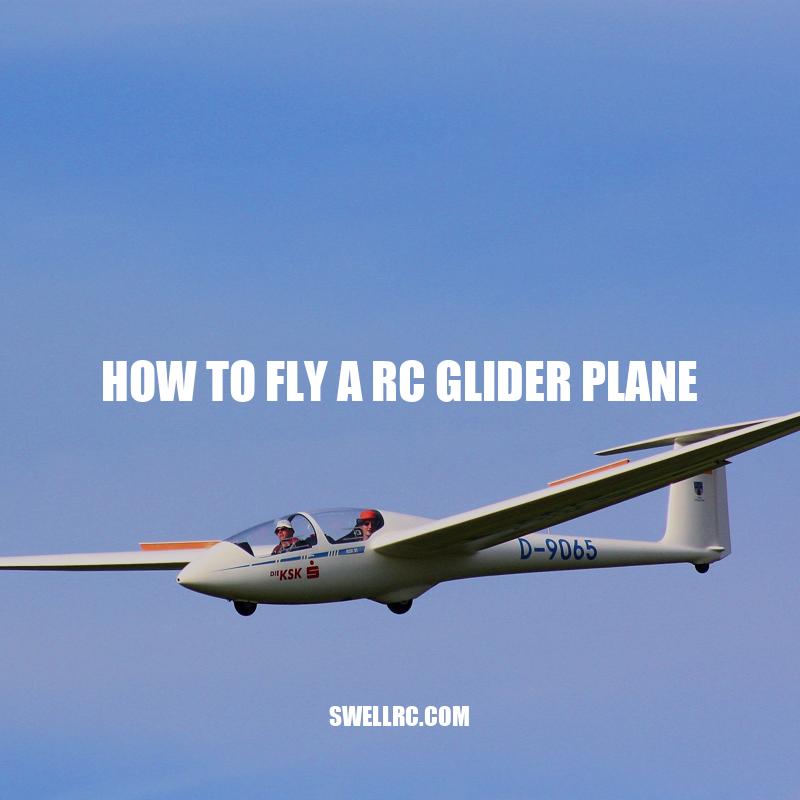How to Fly an RC Glider Plane: Tips for Beginners.
Radio-controlled (RC) glider planes are a popular choice for aviation enthusiasts and beginners alike. These glider planes come in different shapes and sizes, from compact and lightweight designs to large and robust ones that can soar up to great heights. RC glider planes are powered by electric motors or sometimes just by wind currents. Despite being relatively easy and affordable to acquire, piloting an RC glider plane can be a challenging task. There are several key steps to learn to operate the RC glider plane effectively, including selecting the right plane, performing preflight checks, knowing different flight techniques, and, most importantly, mastering takeoff and landing.
Before diving right into flying an RC glider plane, it is essential to choose the right glider plane based on one’s experience level, location, and budget. RC glider planes come in different shapes and sizes and offer various features such as electric engines, different types of propellers, and various kinds of wingspans. If anyone is new to flying an RC glider plane, they may want to start with a smaller, lighter model, which is easier to handle and control. Conversely, if pilots want to fly in open areas with wind currents suitable for soaring, they may want to choose larger models with advanced features such as GPS, gyroscopes or image stabilization. Choosing the right RC glider plane will impact the flying experience and determine how quickly one can progress as a pilot. Once the pilot chooses the right glider plane, the next step is to inspect and assemble the plane.
Choosing the Right Glider Plane
When selecting an RC glider plane, there are many things to consider, including the following:
- Experience level
- Budget
- Flying location and terrain
- Type of motor or propulsion system
- Features such as GPS, gyroscopes, or image stabilization
There are numerous online stores that specialize in RC glider planes, such as Horizon Hobby, Tower Hobbies, and HobbyKing. These stores offer various glider planes from well-known brands, including E-flite, FMS, and Dynam. These online stores provide detailed information for each product, including the size of the plane, features, and specifications, making it easier to select the right glider plane based on the pilot’s criteria. Moreover, these sites provide user reviews, product ratings, and detailed descriptions of each product, which can help in forming an informed decision. In addition, pilots can reach out to online RC glider plane communities, such as RC Groups or RC Universe, for recommendations or advice.
What is the best RC glider for beginners?
- The E-flite UMX Radian is a great option for beginners due to its lightweight and easy-to-fly design.
- The HobbyZone AeroScout S is another good choice for beginners, as it comes with a beginner mode that limits the glider’s altitude and speed.
- For those looking for a more affordable option, the Phoenix Model K8B 3000mm is a great value and has been praised for its stable flight and easy assembly.
Inspection and Assembly of the RC Glider Plane
Before flying an RC glider plane, it’s essential to inspect and assemble the plane correctly to ensure a safe and enjoyable flight. Here are the key steps to follow:
- Inspect the plane: Thoroughly examine the entire structure to detect any visible damages or malfunctioning parts. Check the wing edges, the fuselage, and the tail surfaces. Tighten all the screws to make sure they’re secure.
- Charge the batteries: Motion RC recommends charging the transmitter and the battery in the glider plane for the recommended time specified in their instructions. Avoid overcharging the battery or using damaged batteries.
- Assemble the parts: Follow the manufacturer’s instructions to assemble the glider plane. Install the canopy or cockpit, attach the wings, and connect the control surfaces, servos, and linkages.
- Fine-tune the controls: Double-check the control surfaces and make sure they move smoothly and precisely in response to your commands.
Many online stores, such as Motion RC, offer comprehensive manuals that provide step-by-step guidance on how to assemble various glider planes correctly. Furthermore, learning how to fine-tune the controls may take time, but it is an essential step in maximizing performance during flight. In addition, some RC glider planes come with advanced features, such as self-stabilization systems or retractable landing gear, that require different assembly or calibration procedures. The table below highlights some of the essential parts to inspect and the recommended inspection frequency.
| Parts to Inspect | Recommended Inspection Frequency |
|---|---|
| Wings and fuselage joints | Before every flight |
| Main structural components | Every two flights |
| Control horns and hinges | Every three flights |
How to build a RC glider plane?
Building a RC glider plane can be an exciting project for enthusiasts. Here are some basic steps to get you started:
- Choose a design: Select the type of glider you want to build and gather the materials required.
- Assemble the frame: Begin by assembling the frame of the glider using the materials you have collected.
- Install electronics: Install the necessary electronics such as the motor, servos, and receiver onto the frame.
- Install the wings and control surfaces: Install the wing and control surfaces onto the frame and connect them to the electronics.
- Balance the glider: Test the glider to ensure it is balanced and adjust weights as needed.
- Test fly the glider: Test fly the glider and make any necessary adjustments before taking it for a full flight.
There are plenty of online resources and tutorials available that can provide detailed step-by-step guides, as well as products such as glider kits and parts to help you with your project.
Pre-Flight Checks
Before taking off, you must ensure that your RC glider plane is ready for flight. Here are some of the critical pre-flight checks to perform:
- Battery and Transmitter: Check that the transmitter and the glider plane’s batteries are fully charged and that their power levels are adequate for the intended flight duration
- Control Surfaces: Move the control surfaces, check their responsiveness, and ensure they move in the correct direction of the transmitter stick
- Balance and Stability: Confirm that the glider plane’s weight is evenly distributed, and the center of gravity is at the recommended position. An imbalanced plane would be difficult to control
- Weather Conditions: Check that the wind speed and direction is optimal for flying an RC glider plane. Rain, snow, and fog can also affect visibility and performance
- Flight Plan: Plan the takeoff and landing site, the intended flight path, and the desired altitude. It’s essential to ensure you have enough space to turn, avoid obstacles, and land safely.
In case of doubts or questions, consult online resources such as communities or groups like the Reddit RC Gliders, AMA modeling community, or RC Discuss forum. They offer helpful tips, suggestions, and advice on how to perform pre-flight checks and solve any issues you might encounter. Online stores such as Horizon Hobby and Tower Hobbies offer stores that sell RC Glider Planes, and they are helpful in providing resources such as manuals, videos, and live chat support. By performing thorough pre-flight checks, you can ensure that your RC glider plane operates correctly, mitigate the risk of crashes and injuries, and maximize your flying experience.
How long can a RC glider stay in the air?
RC (radio-controlled) gliders can stay in the air for varying lengths of time depending on their design and the flying conditions. On average, a well-built RC glider can stay in the air for 30 to 40 minutes. However, with the right thermal conditions, gliders have been known to stay in the air for several hours. Some factors that affect how long a glider can stay in the air include:
- The glider’s size and weight
- The shape and size of the wings
- The quality of the glider’s construction
- The flying conditions (wind speed, thermals, etc.)
- The pilot’s skill level
If you’re interested in RC gliders and want to learn more, check out websites such as rcgroups.com and soaringusa.com. These sites offer a wealth of information about various types of gliders and their capabilities. Additionally, if you’re in the market for an RC glider, both websites offer a selection of gliders for purchase.
Launch and Flight
It’s time to take to the skies! Here are some tips for launching and flying an RC glider plane:
- Launch Technique: The method of launching can impact the plane’s performance. Here are some common methods:
- Hand Launch: Hold the plane on the wing, pull the throttle, point it up to a 45-degree angle, and give the plane a gentle toss upwards.
- Bungee Launch: Use a rubber band or bungee cord to provide additional force, as you hold the glider plane or fix it on a launch system.
- Winch Launch: A motorized winch system winds a towline attached to the glider plane, and the glider is launched into the air.
- Control: Use the transmitter sticks to control the glider plane. Here’s an overview:
- Right Stick: Controls the Ailerons (roll)
- Left Stick: Controls the Elevator (pitch)
- Throttle: Controls the motor’s speed
- Rudder: Controls the yaw (left/right) movement of the plane
- Flying Techniques: Here are some of the common tricks to try when flying an RC glider plane:
- Thermalling: This is the technique where the glider plane circles within the rising thermal air to gain altitude without the use of the motor.
- Dynamic Soaring: This allows the glider plane to take advantage of wind shear and rapidly change direction to attain fast and sustained forward speeds.
- Slope Soaring: This is where the plane uses the lift as it is pushed up by the wind as it encounters a slope or a hill.
To master launching and flying an RC glider plane, continuous learning through practice and online resources is helpful. Horizon Hobbies offers free RC flight lessons and RC instruction books that come with some of their planes. Additionally, Check out popular online communities such as Reddit RC Gliders, AMA modeling community, or RC Discuss forum to learn from experienced pilots and join discussions.
How do you launch a RC glider?
Launching an RC glider can be a tricky task, but with the right technique, it can be easily accomplished. The following are the steps to launch an RC glider successfully:
- Make sure the glider is lined up with the wind direction
- Hold the glider in your dominant hand by the wing tips
- Run into the wind while throwing the glider gently upwards and slightly forwards
- Release the glider once it gains enough speed and altitude
Remember that practice makes perfect, and with some patience and determination, you’ll soon be launching your RC glider like a pro. For more information and tips, check out the website of the RC airplane or glider manufacturer you purchased from.
Landing the glider plane
Landing an RC glider plane can be challenging, but it’s essential to avoid damaging the plane, its parts, or hurting the people nearby. Follow these tips to make a safe and smooth landing:
- Choose a suitable landing spot: Look for a clear and flat area to land the plane, preferably at least the size of a football field.
- Plan the approach: Plan the approach path before landing and use the pitch and throttle to slow the plane down.
- Flare the glide: Just before touchdown, flare the plane’s glide, lifting the nose slightly to reduce the speed.
- Reduce throttle: Turn off the throttle or reduce power just before touchdown, making the touchdown as smooth as possible.
- Keep going: Ease the controls gradually after landing to prevent the plane from bouncing back into the air or veering off course.
- Practice: Landing can be challenging and needs a lot of practice. If you are not confident, consider practicing approach and landing techniques with a simulator or in a safe flying field under a trainer’s guidance.
Horizon Hobby offers a wide range of RC gliders and planes with various features to help you learn how to fly and land with ease, and they have a great website that offers support and customer service. Also, check for instructional videos on YouTube or forums such as RC Groups for gliding and landing techniques.
What are Glider Planes Used For?
Glider planes are aircraft that do not have an engine and rely on gravity, air currents, and pilot skills to remain in the air. Here are some common uses of these planes:
- Recreational activities such as leisurely flying or competition soaring
- Training pilots to improve their skills, especially in handling emergency situations
- Aerial photography or surveying, as gliders can fly at lower speeds and altitudes than powered aircraft without causing noise pollution
- Scientific research on atmospheric and weather conditions
If you’re interested in experiencing glider flying or getting trained, you can check out websites of clubs and schools that offer gliding lessons, such as the Soaring Society of America or British Gliding Association.
Conclusion
Learning how to fly an RC glider plane can be a fun and rewarding experience, but like any activity, it requires patience, practice, and careful approach. In summary:
- Choose the right RC glider plane based on your skills, budget and environment
- Inspect and assemble the plane carefully before every flight
- Conduct pre-flight checks on batteries, transmitters, and controls before taking off.
- Practice different flying techniques, including soaring and thermalling.
- Be safe and considerate of others when flying in public spaces
- Always look for opportunities to learn from other pilots and resources such as websites, forums and instructional videos.
By following these tips, you’ll be well on your way to becoming a skilled RC glider pilot. The important thing is always to have fun and enjoy the beauty of the glider plane soaring in the sky.



